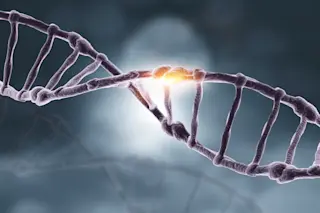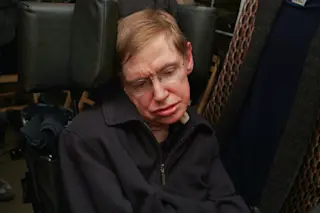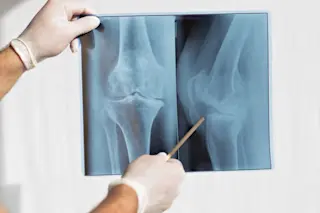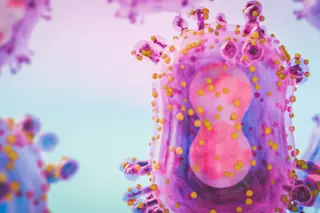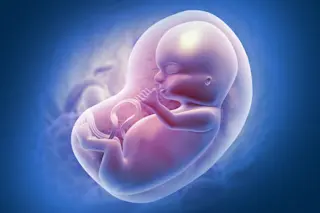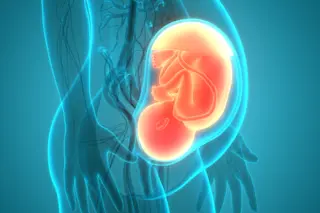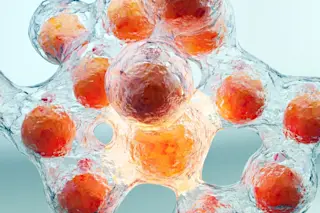One of the things that happens if you read ethnographically thick books like Nicholas Dirks' Castes of Mind: Colonialism and the Making of Modern India is that you start to wonder if most castes were simply created by the British and for the British. Granted, even Dirks would not deny the existence of Brahmins prior to the British period, but those who work within his general paradigm might argue that a group like Kayasthas were the product of very recent developments (e.g., the uplift of a non-Brahmin literate group willing to serve Muslim and British rulers). The emergence of genomics complicates this sort narrative, because you can examine relationships and see how plausible they would be given a particular social model. Zack Ajmal is now at 90 participants in the Harappa Ancestry Project. He's still undersampling people from the Indo-Gangetic plain between Punjab and Bengal, but that's not his fault. Hopefully that will change. He posted K = 4 recently for the last 10 participants, but I notice K = 12 in his spreadsheets. So this is what I did: 1) I aligned the ethnic identification information with the K = 12 results. 2) I removed relatives and those who were not 100% South Asian. 3) I added some reference populations in. These are all upper case below. All other rows are individuals (HRP numbers provided). 4) I removed five ancestral groups. The three Africans, Papuans, and Siberians. Then I arranged the rows alphabetically by ethnic identification. Helpfully many people provided their caste information as well. I've uploaded a csv with the information. But skim the plots & table below. Those of you who are brown can probably make more sense of them than I can. But I think some of the patterns are pretty interesting already. For me the big thing that jumps out is how uniform some of these caste groups are. Remember that HRP22 and HRP23 are my parents. If the British made these groups up, they were very punctilious about their ancestral make up in constituting them! First, this is the visualization of the genetic distance between the groups below:
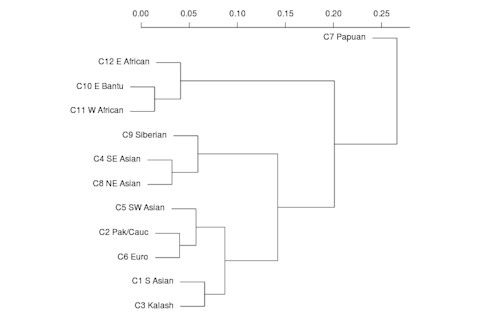
Most South Asians in the Harappa Ancestry Project are S Asian + Baloch/Caucasian + European. In that order. But there are some weird patterns which other genome bloggers have already noted, but I thought would be nice to reiterate with Zack's larger data set.
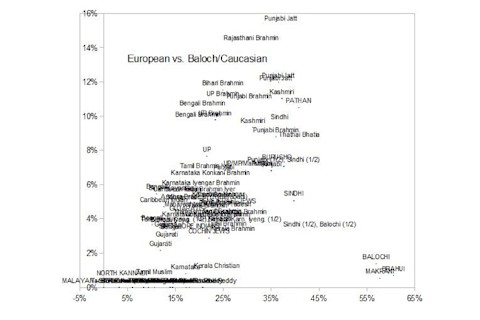
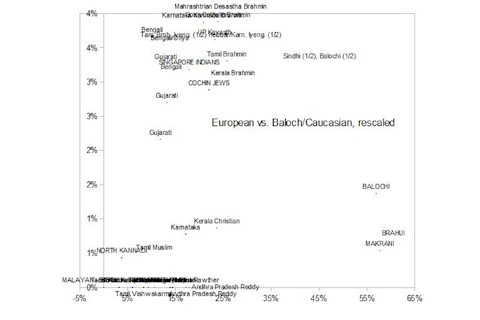
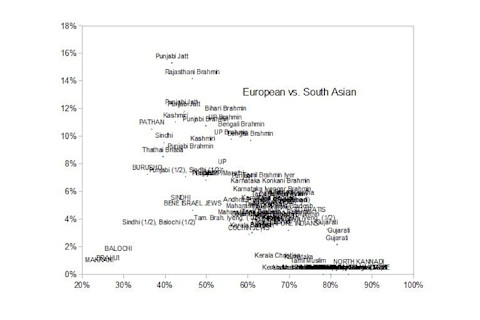
There's a pretty interesting disjunction between the Baloch/Caucasian and European components. Mind you, these are very close genetically. But it's very instructive that their lowest frequency in the northern parent of the continent is focused around the Brahui, a Dravidian group amongst the Baloch in Pakistan. To a great extent aside from the language, the Brahui, Baloch, and Makrani are interchangeable. And the Dravidian groups in Southern India seem to lack it, excluding those who are likely relatively newcomers, the Brahmins and the Jews.
IDEthnicityS AsianBaloch/CaucKalashSE AsianSW AsianEuropeanNE Asian
HRP0060Andhra Pradesh78%14%1%4%0%0%1%
HRP0061Andhra Pradesh77%14%3%3%0%0%0%
HRP0024Andhra Pradesh (Hyderabadi)65%21%3%4%1%5%0%
HRP0009Andhra Pradesh Reddy76%18%2%1%0%0%2%
HRP0076Andhra Pradesh Reddy74%21%1%1%0%0%1%
BALOCHI29%57%3%0%6%1%0%
BENE ISRAEL JEWS47%26%2%1%17%5%0%
HRP0049Bengali69%11%4%6%0%5%3%
HRP0023Bengali64%10%2%11%1%4%2%
HRP0022Bengali63%14%1%11%0%3%5%
HRP0054Bengali Brahmin61%20%4%3%0%10%0%
HRP0077Bengali Brahmin58%21%5%1%0%10%2%
HRP0050Bengali/Oriya68%14%1%5%1%4%2%
HRP0003Bihari Brahmin55%25%4%0%0%12%2%
HRP0032Bihari Kayastha71%14%4%3%0%5%1%
BRAHUI26%60%3%0%6%1%0%
BURUSHO36%36%8%2%0%7%5%
HRP0028Caribbean Indian69%15%3%3%1%5%1%
HRP0027Caribbean Indian66%13%3%5%0%5%0%
COCHIN JEWS60%22%1%3%8%3%0%
HRP0026Goan Catholic Brahmin64%24%4%0%0%4%3%
HRP0058Gujarati82%13%2%0%0%3%0%
HRP0068Gujarati82%12%3%0%0%2%0%
HRP0071Gujarati79%13%2%1%1%3%0%
GUJARATIS75%17%2%0%0%4%0%
HRP0078Karnataka72%17%3%3%2%1%0%
HRP0017Karnataka Iyengar65%24%3%2%0%5%0%
HRP0079Karnataka Iyengar Brahmin66%20%4%1%1%6%0%
HRP0088Karnataka Kannada Brahmin67%21%3%1%0%4%0%
HRP0025Karnataka Konkani Brahmin66%22%1%3%1%6%0%
HRP0044Kashmiri49%31%6%0%1%9%3%
HRP0021Kashmiri43%37%6%0%1%11%0%
HRP0067Kerala Brahmin61%27%3%2%1%3%1%
HRP0038Kerala Christian67%24%3%3%1%1%0%
HRP0053Kerala Muslim Rawther72%17%3%2%1%0%3%
HRP0090Maharashtra/Madhya Pradesh65%22%4%0%0%4%2%
HRP0047Mahrashtrian Desastha Brahmin64%24%5%1%0%4%0%
MAKRANI24%58%3%0%7%1%0%
MALAYAN – KERALA TRIBE84%0%0%8%0%0%2%
NORTH KANNADI87%4%0%4%1%0%1%
PATHAN37%41%6%1%2%11%0%
HRP0064Punjabi59%25%4%2%0%7%0%
HRP0012Punjabi50%35%4%0%1%7%2%
HRP0073Punjabi49%33%6%0%1%7%1%
HRP0086Punjabi (1/2), Sindhi (1/2)45%38%7%0%2%7%0%
HRP0019Punjabi Brahmin50%30%5%0%0%11%1%
HRP0004Punjabi Brahmin46%36%6%0%0%9%0%
HRP0006Punjabi Jatt45%36%4%1%1%12%0%
HRP0005Punjabi Jatt44%36%5%1%0%12%0%
HRP0008Punjabi Jatt42%37%5%0%0%15%0%
HRP0033Rajasthani Brahmin47%31%5%2%0%14%0%
SAKILLI – TAMIL DALIT86%6%0%4%1%0%1%
SINDHI44%40%5%0%1%5%0%
HRP0062Sindhi40%37%9%0%2%10%0%
HRP0039Sindhi (1/2), Balochi (1/2)39%45%5%1%3%3%0%
SINGAPORE INDIANS70%18%3%3%0%3%1%
HRP0055Sourastrian70%16%1%4%0%5%0%
HRP0031Sri Lankan (1/2), Telegu (1/2)82%8%2%5%0%0%0%
HRP0014Tamil Brahmin67%24%1%1%0%5%0%
HRP0084Tamil Brahmin66%22%4%2%0%4%1%
HRP0016Tamil Brahmin66%26%4%1%0%3%0%
HRP0057Tamil Brahmin64%24%3%2%0%5%0%
HRP0048Tamil Brahmin63%25%4%2%0%4%0%
HRP0072Tam. Brah. Iyeng. (1/2) Hebbar/Karn. Iyeng. (1/2)64%22%5%1%0%4%1%
HRP0041Tamil Brahmin Iyer67%22%2%1%0%5%1%
HRP0075Tamil Brahmin Iyer65%21%3%2%0%7%0%
HRP0013Tamil Muslim75%11%4%6%2%0%0%
HRP0066Tamil Nadar81%11%1%2%1%0%3%
HRP0007Tamil Nadar80%9%1%5%2%0%0%
HRP0065Tamil Nadar78%14%0%3%1%0%1%
HRP0070Tamil Vishwakarma87%3%0%2%2%0%4%
HRP0069Tamil Vishwakarma83%8%0%3%1%0%0%
HRP0085Thathai Bhatia40%41%8%0%0%9%0%
HRP0051UP54%22%2%4%6%8%0%
HRP0029UP Brahmin56%23%8%1%0%10%0%
HRP0063UP Brahmin55%25%5%1%0%11%0%
HRP0052UP Kayasth65%23%3%3%0%4%0%
HRP0056UP/MP/Marathi54%29%5%0%0%7%2%





